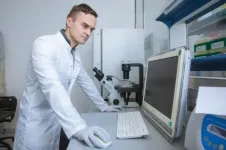INFORMATION:
A new strategy to destroy cancer cells using magnetic nanoparticles and fields
Scientists offered a new method for treating leukemia using nanomaterials
2021-02-11
(Press-News.org) Scientists from Scientific and Educational Center «Smart Materials and Biomedical Applications» under the leadership of Kateryna Levada together with colleagues from Center for Immunology and Cellular Biotechnology of the Immanuel Kant Baltic Federal University conducted a joint interdisciplinary study on the development of a new method for treating leukemia using nanomaterials. The scientists analyzed how magnetic nanoparticles can be manipulated in in vitro conditions to achieve a selective antitumor effect. The method is based on the combined action of nanoparticles and permanent magnetic fields on human tumor cells.
Leukemia (lymphoblastic leukemia) is the most common type of blood cancer in children and adolescents. This cancer affects the bone marrow and leads to the degradation of the human immune system. It accounts for 75-80% of acute leukemias, which also affect adults. Current methods of treating leukemia are based on chemotherapy. But chemotherapy is expensive and toxic not only for cancer cells, but also for the entire body. To overcome these limitations, new approaches using nanomaterials are needed. In their work, the researchers used magnetic nanoparticles and constant magnetic fields.
For the study, the scientists used magnetic iron oxide nanoparticles, as they are a promising basis for the development of biomedical applications. Such materials are biocompatible and can be modified in the future, for example, with fluorescent labels (for microscopic methods), as well as covered with various shells. The development of targeted antitumor drugs requires studying the effect of the material used not only on cancers, but also on healthy cells of the body. The first cell line - mononuclear cells of human blood, served as a model of healthy cells. The second is human lymphoblastic leukemia cells, a cell line under the special name "Jurkat". Thus, the scientists simultaneously studied the effects of magnetic fields and nanoparticles on healthy and cancerous human cells. Permanent magnets, which were fixed in a stationary position in culture plates, were used as sources of the magnetic field. They supported the magnets to prevent any displacement during experiments. After placing all the necessary components, the plates with the cells were placed on top of the plates - this ensured a uniform distribution of magnetic fields on the surface of the plates containing the wells with the cells.
The results of the study showed that the combined effect of nanoparticles and magnetic fields after 24 h treatment affected the Jurkat cells - their viability was decreased. Iron oxides have been found to penetrate cancer cells and cause the release of reactive oxygen species, disrupting cellular processes. Scientists were particularly interested in the fact that healthy cells (human blood mononuclear cells) were not in any way suppressed by this "therapy".
"Thus, the use of nanoparticles based on iron oxides with optimized characteristics (shape, size, chemical composition) will allow in the future to achieve a therapeutic effect by generating reactive oxygen species in cancer cells. The difference in the susceptibility of healthy body cells and tumor cells to the effects of nanoparticles will provide a selective therapeutic effect and, therefore, minimize side effects," says Larisa Litvinova, MD, Director of Center for Immunology and Cellular Biotechnology IKBFU.
"The interdisciplinary approach in this study, namely, the joint work of scientists from various scientific fields, allowed us to demonstrate the interaction of these nanomaterials with cell cultures and, thus, to reveal the potential application significance of our developments. We also express our deep gratitude to our collaborators - Center for Immunology and Cellular Biotechnology IKBFU, under the leadership of Larisa Litvinova, for a joint interesting and productive scientific project," commented Kateryna Levada, PhD, Head of the Laboratory of Biomedical Applications of the Scientific and Educational Center "Smart Materials and Biomedical Applications".
ELSE PRESS RELEASES FROM THIS DATE:
One dose of COVID-19 vaccine provokes strong immune response in those previously infected
2021-02-11
Although clinical trial data are encouraging, real-world evidence with regard to the COVID-19 vaccine remains scarce. In particular, response to the vaccine among those previously infected with SARS-CoV-2 is still not completely understood.
Researchers from Bar-Ilan University and Ziv Medical Center now report preliminary evidence that people previously infected with the virus responded very strongly to one dose of the Pfizer vaccine, regardless of when they were infected and whether or not they had detectable antibodies against COVID-19 prior to receiving the vaccine.
Their study, published on February 11, 2021 in the journal Eurosurveillance, was conducted on a cohort of 514 staff members at Ziv Medical Center. Seventeen ...
Hope for children with bow hunter syndrome
2021-02-11
DALLAS - Feb. 11, 2021 - Fusing the neck's top two vertebrae can prevent repeat strokes in children with bow hunter syndrome, a rare condition that affects a handful of U.S. pediatric patients each year, UT Southwestern researchers suggest in a recent study. The finding, published online in Child's Nervous System, offers a new way to treat these children and protect them from potentially lifelong neurological consequences.
Bow hunter syndrome - so named because of the head's position when a person is shooting an arrow - is a condition affecting children and adults in which turning the head compresses blood vessels supplying the back of the brain from the vertebral artery. In adults, this condition ...
At least 50% of COVID-19 infections come from people who aren't showing symptoms
2021-02-11
A new study out of the University of Chicago has found that during the initial wave of the COVID-19 outbreak in New York City, only 1 in 5 to 1 in 7 cases of the virus was symptomatic. The research team found that non-symptomatic cases substantially contribute to community transmission, making up at least 50% of the driving force of SARS-CoV-2 infection. The results were published on Feb. 10 in the Proceedings of the National Academy of Sciences.
When the COVID-19 epidemic arrived in the U.S., the investigators noticed that it was very difficult to estimate what proportion of people infected with SARS-CoV-2 would go on to develop symptoms, partially due to the initial challenges with testing capacity.
"Without ...
Misuse of opioid drugs during pregnancy could have lasting impact on child's development
2021-02-11
As the number of pregnant women using opioid drugs continues to rise, questions have been raised about the long-term health effects on children exposed to these drugs in the womb. Researchers at the University of Maryland School of Medicine now have preliminary but striking evidence that suggests that such exposure can cause long-lasting impairment in the brain's ability to process sensory information. These impairments may give rise to autism, attention deficit hyperactivity disorder, and substance use disorders during adolescence. The landmark study, recently published in Journal ...
Ebola is a master of disguise
2021-02-11
It was once thought that Ebola and related filoviruses were more or less contained to Central Africa. After a West African outbreak and the discovery of Reston ebolavirus in the Philippines, cuevavirus in Spain and various bat filoviruses in China, researchers now understand that this viral family--causing hemorrhagic fevers with up to 90% case fatality rates--has been widespread around the world for millions of years.
Our defenses against it are more embryonic, and though we have a vaccine against one species of Ebola and some therapeutic antibodies on the horizon, both have production or distribution issues. What doctors ...
Study: Reparations for slavery could have reduced COVID-19 infections and deaths in US
2021-02-11
At a glance:
New study suggests monetary reparations for Black descendants of people enslaved in the United States could have cut SARS-CoV-2 transmission and COVID-19 rates both among Black individuals and the population at large.
Researchers modeled the impact of structural racism on viral transmission and disease impact in the state of Louisiana.
The higher burden of SARS-CoV-2 infection among Black people also amplified the virus's spread in the wider population.
Reparations could have reduced SARS-CoV-2 transmission in the overall population by as much as 68 percent.
Compared with white people, Black individuals in the United States are more likely to be infected with SARS-CoV-2, more likely ...
Scent detection dogs can identify individuals infected with COVID-19
2021-02-11
In a recent article in the Journal of Osteopathic Medicine, authors gathered previously published research to summarize current thinking on the feasibility and efficacy of using scent detection dogs to screen for the COVID-19 virus. The researchers report that sensitivity, specificity, and overall success rates reported by the canine scent detection studies are comparable or better than the standard RT-PCR and antigen testing procedures.
These findings indicate scent detection dogs can likely be used to effectively screen and identify individuals infected with the COVID-19 virus in hospitals, senior care facilities, schools, universities, ...
New insights to past ecosystems are now available based on pollen and plant traits
2021-02-11
EUGENE, Ore. -- Feb. 11, 2021 -- Researchers have mined and combined information from two databases to link pollen and key plant traits to generate confidence in the ability to reconstruct past ecosystem services.
The approach provides a new tool to that can be used to understand how plants performed different benefits useful for humans over the past 21,000 years, and how these services responded to human and climate disturbances, including droughts and fires, said Thomas Brussel, a postdoctoral researcher in the University of Oregon's Department of Geography.
The approach is detailed in a paper published online ...
A plant's nutrient-sensing abilities can modulate its response to environmental stress
2021-02-11
Palo Alto, CA-- Understanding how plants respond to stressful environmental conditions is crucial to developing effective strategies for protecting important agricultural crops from a changing climate. New research led by Carnegie's Zhiyong Wang, Shouling, Xu, and Yang Bi reveals an important process by which plants switch between amplified and dampened stress responses. Their work is published by Nature Communications.
To survive in a changing environment, plants must choose between different response strategies, which are based on both external environmental factors and internal nutritional and energy demands. For example, a plant might either delay or accelerate its lifecycle, depending on the availability of the stored ...
Once bitten, twice shy: the neurology of why one bad curry could put us off for life
2021-02-11
A negative experience with food usually leaves us unable to stomach the thought of eating that particular dish again. Using sugar-loving snails as models, researchers at the University of Sussex believe these bad experiences could be causing a switch in our brains, which impacts our future eating habits.
Like many other animals, snails like sugar and usually start feeding on it as soon as it is presented to them. But through aversive training which involved tapping the snails gently on the head when sugar appeared, the snails' behaviour was altered and they refused to feed on the sugar, even when hungry.
When the team ...
LAST 30 PRESS RELEASES:
Nanoplastics have diet-dependent impacts on digestive system health
Brain neuron death occurs throughout life and increases with age, a natural human protein drug may halt neuron death in Alzheimer’s disease
SPIE and CLP announce the recipients of the 2025 Advanced Photonics Young Innovator Award
Lessons from the Caldor Fire’s Christmas Valley ‘Miracle’
Ant societies rose by trading individual protection for collective power
Research reveals how ancient viral DNA shapes early embryonic development
A molecular gatekeeper that controls protein synthesis
New ‘cloaking device’ concept to shield sensitive tech from magnetic fields
Researchers show impact of mountain building and climate change on alpine biodiversity
Study models the transition from Neanderthals to modern humans in Europe
University of Phoenix College of Doctoral Studies releases white paper on AI-driven skilling to reduce burnout and restore worker autonomy
AIs fail at the game of visual “telephone”
The levers for a sustainable food system
Potential changes in US homelessness by ending federal support for housing first programs
Vulnerability of large language models to prompt injection when providing medical advice
Researchers develop new system for high-energy-density, long-life, multi-electron transfer bromine-based flow batteries
Ending federal support for housing first programs could increase U.S. homelessness by 5% in one year, new JAMA study finds
New research uncovers molecular ‘safety switch’ shielding cancers from immune attack
Bacteria resisting viral infection can still sink carbon to ocean floor
Younger biological age may increase depression risk in older women during COVID-19
Bharat Innovates 2026 National Basecamp Showcases India’s Most Promising Deep-Tech Ventures
Here’s what determines whether your income level rises or falls
SCIE indexation achievement: Celebrate with Space: Science & Technology
Children’s Hospital Colorado performs region’s first pediatric heart and liver dual organ transplant
Australian team discover why quantum computers have memory problems over time
What determines the fate of a T cell?
Candida auris: genetic process revealed which could be treatment target for deadly fungal disease
Groundbreaking discovery turns household plastic recycling into anti-cancer medication
Blocking a key inflammatory pathway improves liver structure and vascular function in cirrhosis, study finds
Continuous spread: Raccoon roundworm detected in nine European countries
[Press-News.org] A new strategy to destroy cancer cells using magnetic nanoparticles and fieldsScientists offered a new method for treating leukemia using nanomaterials



